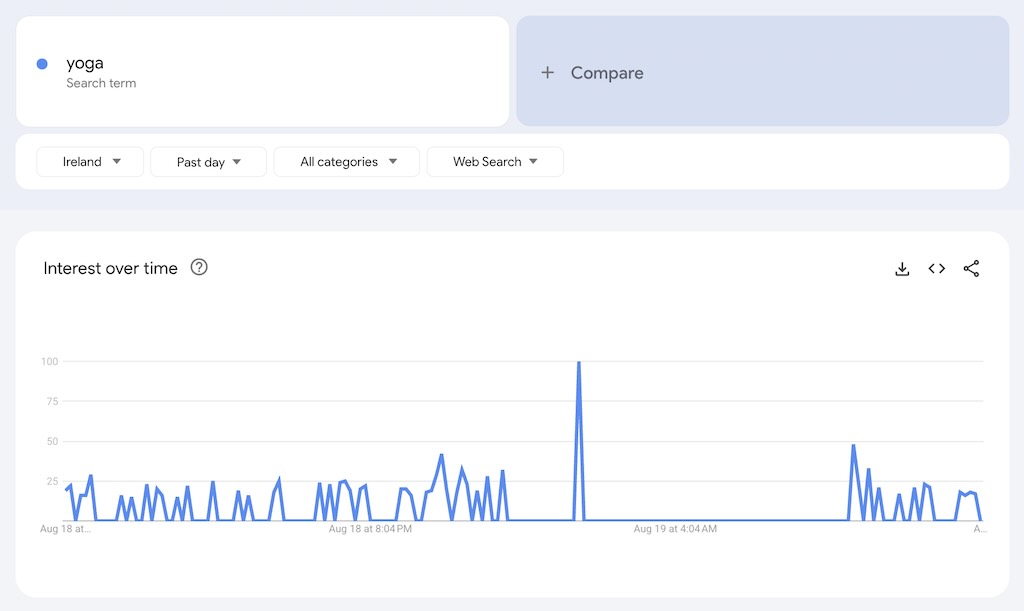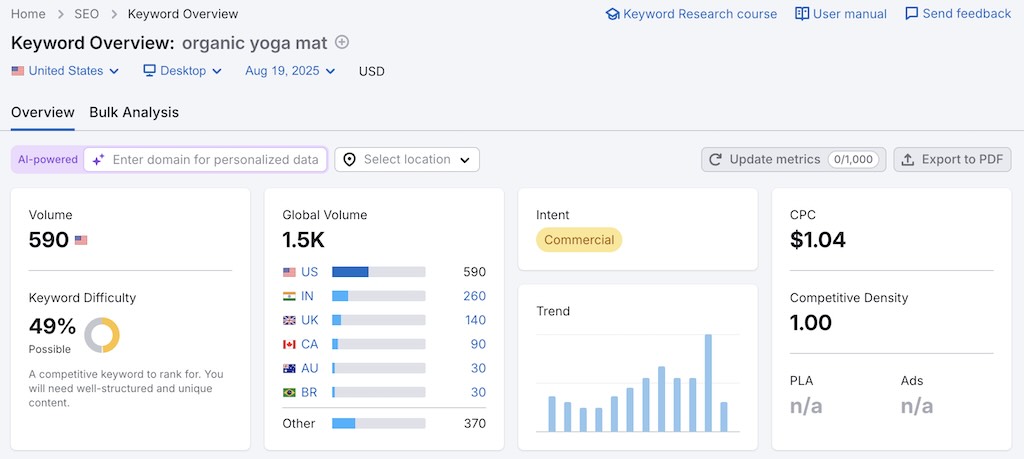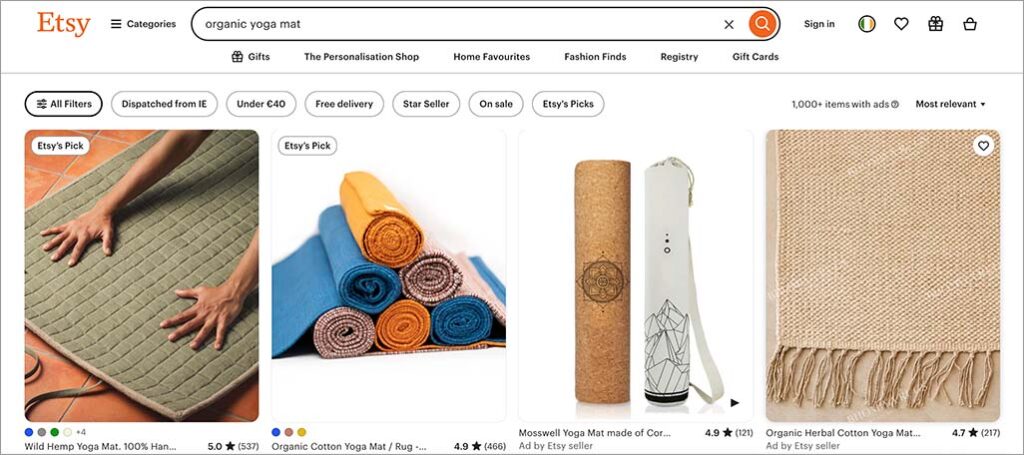When you’re starting out in ecommerce, the first — and most important — decision you’ll need to make is what you’re actually going to sell.
This, in effect, means finding an ecommerce niche. Pick the right one and you’ll find it easier to stand out in search results, reach customers and turn store visitors into buyers.
Pick the wrong one and you could spend months (and a lot of money!) trying to sell products that nobody’s really interested in.
So, in what follows, I’ll walk you through the process of finding an ecommerce niche — and crucially, a profitable one.
1. Get a clear understanding of what a niche is
Understanding exactly what a niche is is vital if you want to find a profitable one.
So, let’s get clear on that.
An ecommerce niche is a specific part of a market that you decide to target.
For example, instead of selling ‘sports equipment,’ you might sell yoga mats made from recycled materials. Rather than becoming a ‘home décor’ merchant, you might zero in on Scandinavian-style lighting for small apartments.
Why narrow things down like this? Well, in most cases, doing so means that…
- you’ll face less competition from other sellers than you would in a broader, more saturated market
- your marketing will be more targeted — meaning you can spend less on ads while getting better results
- you may find it easier a loyal customer base — people are more likely to buy from (and recommend) a store that clearly caters to their specific needs.
2. Aim for the sweet spot: passion + profit
The best niches tend to lie at the intersection of what you’re interested in and what people will pay for.
- Passion matters for two reasons. First, if you’re not able to show excitement about a product (via your store, blog or marketing material), you’re not going to convince people to buy it. And second, building an online store is a long-term commitment. If you can’t imagine talking about a topic or product for years, you’ll probably find yourself getting bored or burnt out by your business.
- Profit matters because enthusiasm alone won’t keep the lights on.
So, ask yourself:
- What topics or industries am I genuinely interested in?
- Could I create content about them without feeling bored?
3. Research the demand
Once you’ve got some product ideas, you’ll need to check whether people are already buying the sort of items you’d like to sell.

You can find this out via:
- Google Trends — this free service shows lets you see whether interest in a particular product niche is stable, growing, or shrinking over time.
- keyword tools — SEO platforms like Ahrefs and Semrush show you how many people search for specific product keywords each month
- online marketplaces — you can browse Amazon, Etsy, or eBay to see what’s selling well
- social media — you can check Instagram hashtags, TikTok trends, or Pinterest boards to spot products people are excited about
- online communities — you can explore forums or Reddit and Quora threads to see if there’s demand for the kinds of things you’d like to sell.
💡 Tip: be careful about building a store around products with huge, short-lived spikes in interest — these can die off quickly (fidget spinners, anyone?).
4. Size up the competition
Competition isn’t automatically a bad thing — in fact, no competition usually means no demand. But too much of it can make life hard for a beginner.
To assess the competitive landscape for your product idea…
- Google your main product keywords — Are the results dominated by major brands or well-known retailers?
- Check ad costs — Use Google Ads’ Keyword Planner to see the “cost per click” for your niche. If it’s sky-high, you may need a bigger budget to compete.
- Look for gaps — Are there underserved sub-niches, or products that are popular but poorly reviewed? These can be opportunities.
- Assess keyword difficulty — using an SEO tool like Ahrefs or Semrush, check the ‘keyword difficulty score’ for queries related to your products. Keyword difficulty scores tell you how difficult it will be to rank highly for a phrase in search results — if they are extremely high for words describing your product range, this is a sign that competition in your niche may be fierce.

5. Work out the numbers
It’s easy to get carried away with a product idea that excites you…but the ecommerce maths has to work or you can forget about any sales.
So, before settling on your niche, consider:
- product cost — what a supplier will charge you for your products
- shipping and packaging — heavy, bulky, or fragile items that cost a fortune to ship can destroy the profitability of an ecommerce business
- marketing spend — how much are advertising, influencer partnerships, and content creation for your product range going to set you back?
- platform fees — it’s important to factor in things like Shopify subscriptions, Etsy fees, payment processor charges, etc.
As a rough guide, aim for a gross profit margin of at least 30%. A bigger one is better of course, because it gives you room to cover overheads and still make money.
6. Think long-term
It’s very important to think about the longevity of your niche. There is usually no point in building a business that’s got a very limited lifespan.
So, ask yourself:
- Will people still want or need to use my product in 3–5 years?
- Is my product going to meet an ongoing need, or it is just tailoring to a passing fad?
For example, a store selling ‘eco-friendly storage solutions’ has a lot more potential to grow over time than one based entirely around last year’s viral kitchen gadget.
7. Factor in supply chain resilience
A product might tick every box for profitability and demand — but if you can’t reliably get it to your customers, your niche is dead in the water.
So, when you’re evaluating a niche, check:
- Supplier diversity — are there multiple suppliers you can work with, or are you dependent on one?
- Geographic spread — are your suppliers based in one country, or do you have options in different regions to mitigate disruptions?
- Local sourcing options — having a domestic “Plan B” supplier can keep orders flowing if imports are delayed.
- Seasonal factors — some products have sourcing bottlenecks at certain times of year; plan ahead for these cycles.
A good niche doesn’t just involve what’s in demand — it’s also about what’s deliverable.
8. Test before you commit to your ecommerce niche
Before you go all-in on a niche idea, it’s important to test its viability.
To do this, consider…
- ordering a small batch of products and try selling them on a marketplace like eBay or Etsy (both are selling platforms that don’t involve monthly fees or much of a time commitment to set up).
- running a small ad campaign to gauge interest in your product range
- creating a simple landing page about your products that collects email from prospective customers
If you see good results from ‘small-scale’ tactics like the above, that’s a strong signal that you can scale things up successfully.

Key takeaways
Finding your ecommerce niche isn’t about focusing on a hyped product — it’s about balancing passion, demand, profitability, and practicality.
By doing your research, checking competition, running the numbers, and assessing supply chain resilience, you’ll be in a much stronger position to start an online store that can grow steadily over the long term.
📖 Related resource: How to start an online store
Chris Singleton is the Founder and Director of Ecommercetrix.
Since graduating from Trinity College Dublin in 1999, Chris has advised many businesses on how to grow their operations via a strong online presence, and now he shares his experience and expertise through his articles on the Ecommercetrix website.
Chris started his career as a data analyst for Irish marketing company Precision Marketing Information; since then he has worked on digital projects for a wide range of well-known organizations including Cancer Research UK, Hackney Council, Data Ireland, and Prescription PR. He then went on to found the popular business apps review site Style Factory, followed by Ecommercetrix.
He is also the author of a book on SEO for beginners, Super Simple SEO.
